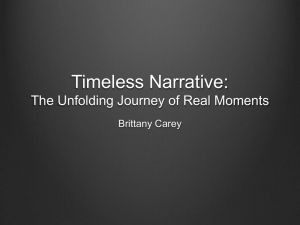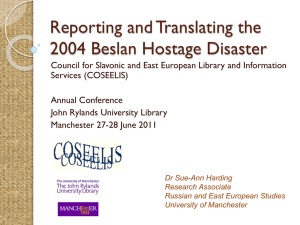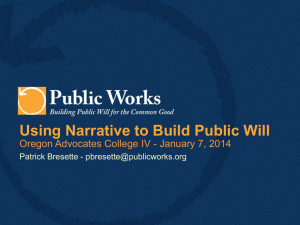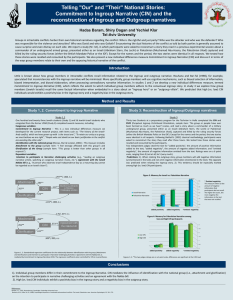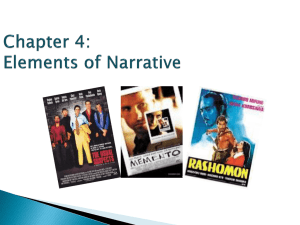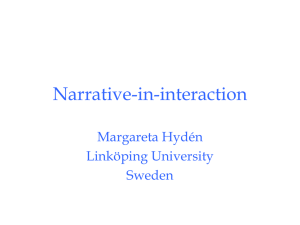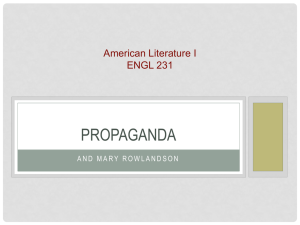Narrative Analysis
advertisement
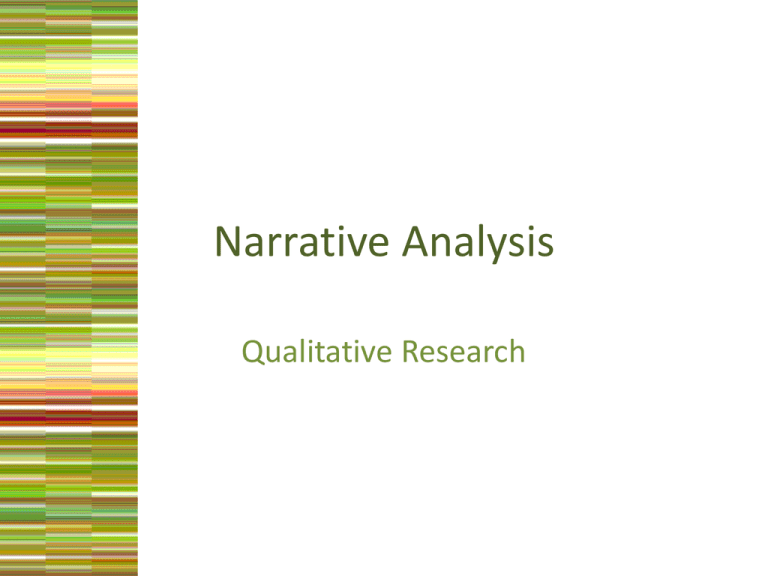
Narrative Analysis Qualitative Research Narrative Analysis Quotations “Humans are storytelling organisms who, individually and collectively, lead storied lives. Thus, the study of narrative is the study of the ways humans experience the world.” 1990) (Connelly and Clandinin, Quotations Narrative Analysis “The oldest and most natural of sense making [are stories]” (Jonassen & Hernandez-Serrano, 2002, p. 66) Development Postmodernist emphasis on reflexivity, positioning the “self”, understanding identity Narrative Analysis Social theory begins to emphasize individual agency over social structure Therapeutic culture, understanding the self Rise of oral history as remedy to systemic exclusion of marginalized populations in conventional history Narrative Analysis What Do Narratives Do? - Help construct individual or group identity Persuade Rationalize Make an argument Teach a lesson - Remember Mobilize Offer perspective Entertain Cope with or make sense of disturbing events/misfortune….. - What else? Narrative Analysis Definition Narrative Analysis: analysis of a chronologically told story - analysis of the stories of research subjects, attempting to understand the relationships between the experiences of the individuals and their social framework What Does Narrative Analysis Do? 1. Focuses on “the ways in which people make and use stories to Narrative Analysis interpret the world” 2. Views narratives as interpretive devices through which people represent themselves and their worlds to themselves and to others What Does Narrative Analysis Do? Narrative Analysis 3. Does NOT treat narratives as stories that transmit a set of facts about the world - not interested in whether stories “true” or not What Does Narrative Analysis Do? Analysis 4. Narrative Views narratives as social products that are produced by people in the context of specific social, historical and cultural locations - - What Can be Studies? - Conversations Myths Epics Narrative Analysis Legend - History (memoir, bio) - Fables - Comedy - Tales - Tragedies - Novellas - Dramas - Mime - Paintings News - Stained glass window - Corp lit. - Etc. What Can be Studies? “. . .narrative is present in every age, in Narrative Analysis every place, in every society; it begins with the very history of mankind (sic) and there nowhere is nor has been a people without narrative…it is simply there, like life itself’.” (Barthes, 1982, as cited in Riessman, 2008, p. 4 and Franzosi, 1998 p. 1) Key Terms Narrative Analysis of an Narrative: the representation event or a series of events - Must have at least one event present Key Terms Narrative Analysis Story : a narrative with a plot Plot: causal chain of events that form a meaningful structure Key Terms Patterns: recurring forms of patter Narrative Analysis (events) Themes: sets of patterns Coding: a system for organizing a collection of defined variables/categories Key Terms Antenarrative: stories not told in the Narrative Analysis and the proper plot sequence mediated coherence preferred in narrative theory (beginning, middle, end) Interview: discursive acts created by the interviewer and respondent Key Terms Temporal organization: organization Narrative Analysis of the narrative according to temporal sequence (time) 3 Approaches Poetic Approach Narrative Sort narrative into either Analysis 1. Epic mode: generates pride, meant to rouse admiration 2. Romantic mode: lighter, sentimental quality; addresses audience’s interest for love, appreciation, and affection 3 Approaches Poetic Approach Narrative Sort narrative into either Analysis 3. Comic mode: intends to amuse the audience; may mock as well 4. Tragic mode: generates pity and sorrow and invites the audience to feel respect and compassion 3 Approaches Poetic Approach Narrative Look for four main criteria Analysis 1. Traits of the protagonist(s) 2. Plot focus 3. Major poetic tropes in use (metaphor, irony, simile, etc) 4. Main emotions at work 3 Approaches Tripartite Approach: Classifies ways of reading 1. Explication: guided by an ambition to simply understand the text Narrative Analysis - What does the text say? a. Stories may not be complete b. Stories may be difficult for outsiders to comprehend c. Good preparation for explanation & explorations 3 Approaches Tripartite Approach: Classifies ways of reading 2. Explanation: examines how the text say what it says by asking: Narrative Analysis - What were the intentions of the author? OR 3 Approaches Tripartite Approach: Classifies ways of reading 2. Explanation: (Cont.) Narrative Analysis - How did the reader create meaning and understanding from the text/what was their experience? AND - What is the process of the text being read? 3 Approaches Tripartite Approach: Classifies ways of reading 2. Explanation: (Cont.) a. must keep in mind the differences that exist between an oral and written text Narrative Analysis 3 Approaches Tripartite Approach: Classifies ways of reading 3. Exploration: readers bring their own experiences and lives into the text as if they were standing in for the author and ask: Narrative Analysis - What does text have to do with me? - What do I do with this text? 3 Approaches Tripartite Approach: Classifies ways of reading 3. Exploration: (Cont.) Narrative Analysis “The social science reader reads in order to become an author: no matter what school of explication or explanation he or she belongs to, no matter whether the reading turns out to be methodological or inspired in kind.” (Czarniawska, 2004, p. 71) 3 Approaches Structural Analysis: Emphasizes a shift to the telling, the way in which a story is told - Focus is on the language of the story (grammar) and its form Narrative Analysis - How a storyteller’s selection of particular narrative devices makes it persuasive. 3 Approaches Structural Analysis: Basic components of a story structure: 1. Abstract (what the story is about) - can be more than one Narrative Analysis 2. Orientation (sets the scene – time, place, characters, and situation) 3. Complicating action (usually a crisis/conflict or turning point) - helps layout what happens next 3 Approaches Structural Analysis: Basic components: Narrative Analysis 5. Resolution: the outcome of the plot – the ending 6. Coda: linking section that returns the story to the present 3 Approaches Structural Analysis: Basic components: Narrative Analysis - Not all stories have all of these structures and they can occur in varying sequences Extra Approach Deconstructive Approach: A stepwise analytical procedure that pursues the meaning of a text to the point of exposing the supposed contradictions and internal oppositions upon which it is founded Narrative Analysis Extra Approach Deconstructive Approach: The idea is to re-author a story so that the hierarchy is resituated and a new balance of views is attained - To re-story in order to remove dualities and margins Narrative Analysis Supposes an active participation of the reader Focused on criticism/critique Extra Approach Deconstructive Approach: Steps: Narrative Analysis 1. List any occurrence of opposite or contradictory terms used in the story 2. Reinterpret the hierarch in place in the story 3. Make unheard voices heard - Who is not being expressed in the story? Who are the subordinates? Extra Approach Deconstructive Approach: Steps: Narrative Analysis 4. Stress the other side of the story and show that each center is in a constant state of change and disintegration 5. Deny the plot and move it around 6. Find the exceptions and state them in a way that makes extreme or absurd Extra Approach Deconstructive Approach: Steps: Narrative Analysis 7. Fill in the blanks with - What is not being said? 8. Resituate the story beyond its dualisms, exclude voices or singular viewpoint NOTE Narrative Analysis There are many, many more ways to analyze a narrative! This is just a beginning look at how it can be done.
